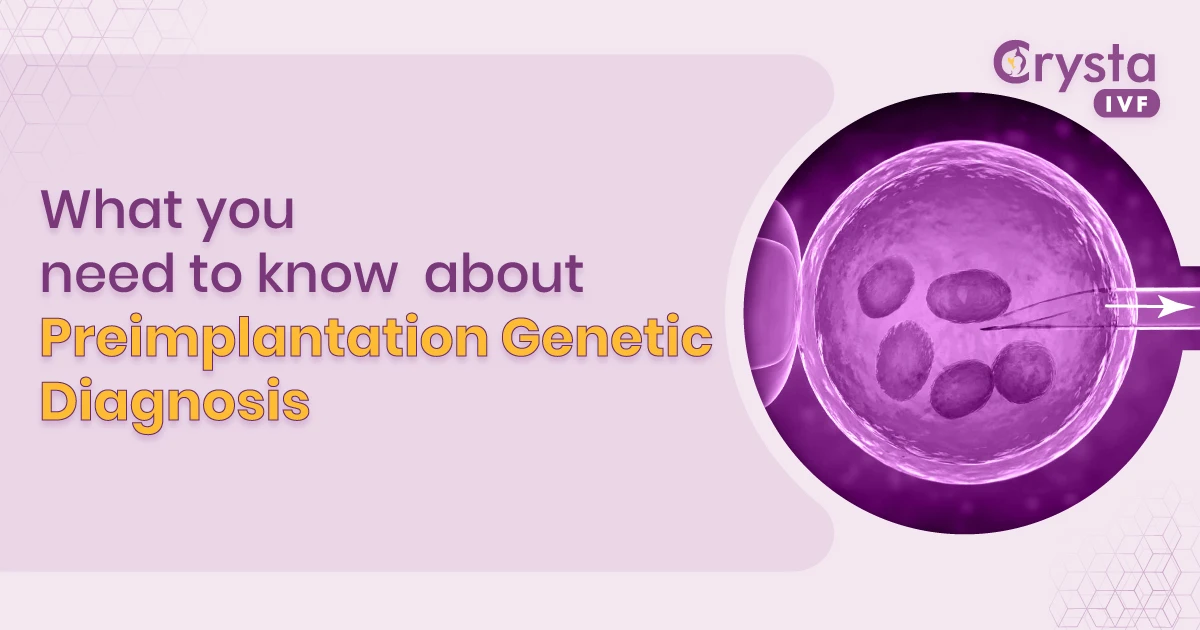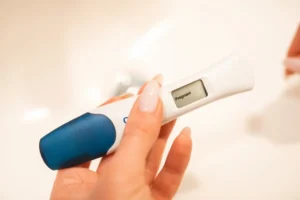If you want to turn your dream of parenthood into reality through IVF, you’ll need to undergo several tests and diagnoses. Doctors recommend these tests to ensure you receive the best treatment for you and your baby. One such test is Preimplantation Genetic Diagnosis (PGD). This test helps doctors determine if the embryo is suitable for transfer to the uterus and free from genetic defects.
During in vitro fertilization IVF treatment, PGD is one kind of genetic test that is conducted by doctors to check if the embryo is healthy and doesn’t have any genetic disorder. With the help of this test, the doctors can select the healthiest embryos. The PGD test raises the likelihood of a successful pregnancy and a healthy kid.
It is the best way to prevent the spread of a certain genetic condition without putting a couple’s unborn child in danger and forcing them to decide whether to end the pregnancy. Continue reading this blog to learn how PGD testing plays a beneficial role in IVF.
What is PGD (Preimplantation Genetic Diagnosis)?
Before the process of implantation, a test known as genetic screening thoroughly checks the chromosomal makeup of an embryo in IVF. This test is specifically used to check the embryo for numerical chromosomal abnormalities or aneuploidy. This diagnosis enables fertility doctors to identify embryos with a standard number of chromosomes, allowing for selective embryo implantation.
Also read: What is the ERA Test?
How is Preimplantation Genetic Diagnosis Done?
PGD testing is a step in the IVF procedure that is done before implanting the embryos in the mother’s uterus. PGD testing procedure involves:
- At first, the ovaries are stimulated with hormones to produce more eggs. Then, at the moment of ovulation, the eggs are extracted.
- Additionally, a sample of sperm is obtained at the same time from the male.
- The process of fertilization is then carried out in a lab by fusing with sperm cells.
- After that, the embryos are given roughly 3 to 5 days to grow by cell division.
- A few fit embryos are extracted and frozen for further tests.
- Genres that could result in genetic disorders are extracted from the DNA of each embryo. Usually, this procedure takes more than a week.
- The genetically fit embryos are extracted after the test results and implanted in the uterus.
- For potential usage in the future, the remaining embryos that do not have genetic issues are further frozen.
- If any embryos are found to have genetic issues, they are discarded.
What Genetic Diseases are Identified with PGD?
Identifying and eliminating embryos that are generating genetic abnormalities during the pre-implantation stage is one of the most important applications of PGD. These diseases include:
- Loss of Amyotrophic Laterality
- Dystrophies Muscular
- Beta Thalassemia
- Breast Cancer
- Fibrosis Cystic
- Hemophilia
- Prostate Cancer
What is PGD Cost? Is it Affordable?
The PGD test is a bit costly due to the need for embryo biopsy and genetic testing. The PGD test cost for embryos is typically not covered by insurance because it is a relatively new procedure, making it highly expensive for the patient.
Health insurance coverage frequently covers the price of genetic testing ordered by fertility doctors. Genetic laboratories determine PGD for every different embryo. The cost rises proportionately to the number of embryos that need testing. Typically, the cost of each embryo exceeds INR 5,000.
Therefore, at Crysta IVF, we understand the problems our customers face. The cost of PGD is easily affordable for the parents. The tests are performed by expert embryologists who examine each embryo with precision.
Also Learn About: What is Blastocyst culture in IVF Treatment?
What are the Factors That Affect PGD Cost?
Additionally, the price of PGD testing may vary greatly among patients. Certain factors that affect PGD cost include:
- The number of embryos to test
- The inheritance pattern of the genetic condition
- The frequency of IVF cycles required
- Egg growth, fertilization, testing and embryo transfer.
- Equipment required for PGD testing
These are all factors that could impact the treatment cost. Preimplantation genetic testing becomes more expensive if further tests are needed.
Note: “At Crysta IVF we provide all our patients with customized tests from the world-class PGD laboratory to obtain the most accurate results.”
Who Should Go for PGD Testing?
Preimplantation genetic diagnosis (PGD) is usually a good option for people or couples who:
- Possess a history of repeated miscarriages or failure IVF rounds:
PGD can assist in identifying embryos that possess chromosomal abnormalities or genetic flaws that might have played a role in prior miscarriages or failed IVF treatments.
- Parents who have previous genetic disorders:
People may choose to undergo PGD to lower their chance of passing on hereditary diseases like Huntington’s disease, sickle cell anemia, or cystic fibrosis to their offspring.
- Carriers of genetic mutations:
People may have mutations that could be passed on to their babies even if they do not personally display the signs of a genetic illness. Embryos without these mutations can be identified with PGD.
- Unidentified cause of fertility:
When there is no known cause for infertility, PGD can help identify any genetic problem that may be involved and help choose the best course of action.
Preimplantation Genetic Diagnosis Pros & Cons
You should examine the pros & cons of PGD before proceeding, as it is a very costly procedure overall.
The benefits of PGD include:
- It lowers the chance of producing offspring with chromosomal abnormalities.
- Women who have experienced miscarriages in the past but cannot explain why it is happening could get an answer with PGD.
- If the fetus has an abnormal chromosomal count, it helps decide whether to continue or terminate the pregnancy.
- The procedure lowers the number of transferred embryos needed for conception and the chance of miscarriage for women over 36.
The drawbacks of PGD include:
- It doesn’t help in correcting the genetic problem.
- The price of undergoing PGD tests is high.
Also Read: What Are The Various IVF Tests Performed Before Undergoing IVF?
Where to Go for PGD Testing?
If you are concerned about the embryos before implantation and want to have a healthy kid, immediately approach Crysta IF for a preimplantation genetic diagnosis (PGD) test. This test is offered at the highest caliber of assisted reproductive technology. Our team of professionals is committed to performing precise genetic analysis at the blastocyst stage, using the latest laboratory facilities and technology.
We at Crysta IVF are aware of the critical role that PGD plays in family planning. Our expert laboratory technicians carefully remove the trophectoderm cells needed for genetic testing during embryo biopsies. With this accuracy, couples may confidently work toward the birth of healthy children who are free from known genetic illnesses or chromosomal abnormalities.
Contact at IVF center in Delhi to get your PGD done at an affordable price.
Frequently Asked Questions
What is a preimplantation genetic diagnosis?
Preimplantation Genetic Diagnosis (PGD) is a technique used during IVF to test embryos for specific genetic disorders before they are implanted in the uterus. It helps reduce the risk of passing inherited conditions to the baby.
What are the risks of PGD?
The risk due to PGD differs from patient to patient. However, some of you might face such risks:
- Possible damage to the embryo during cell biopsy (though rare)
- False positives or negatives in the results
- Emotional and financial stress
- Not finding any healthy embryos for transfer
What is the importance of PGD?
PGD is important for couples with a known risk of genetic diseases. It helps ensure only genetically healthy embryos are used, increasing the chances of a healthy baby and reducing the risk of miscarriage due to chromosomal abnormalities.
What are the benefits of preimplantation genetic diagnosis?
The benefits of preimplantation genetic diagnosis include:
- Prevents transmission of genetic disorders
- Increases IVF success by selecting viable embryos
- Reduces miscarriage risks
- Helps choose embryos with the highest potential for implantation
Does the PGT test for gender?
Yes, Preimplantation Genetic Testing (PGT) can determine the gender of the embryo by analysing the sex chromosomes, especially through PGT-A (formerly known as PGS). However, gender selection is not allowed for non-medical reasons in India.
What is a PGD?
PGD stands for Preimplantation Genetic Diagnosis. It is a form of genetic screening used with IVF to identify embryos free from specific inherited conditions before implantation.
Is PGD successful in IVF?
Yes, PGD can increase IVF success in specific cases, especially for couples with genetic disorders or recurrent pregnancy loss. It helps select the healthiest embryos, improving chances of pregnancy and live birth.
How much does PGT cost?
The cost of PGT/PGD in India can exceed ₹50,000, depending on the clinic, number of embryos tested, and the type of genetic analysis done. It is usually an additional cost on top of IVF treatment.
Who developed preimplantation genetic diagnosis?
PGD was first developed in the late 1980s by researchers Alan Handyside and Robert Winston in the UK. It was initially used to detect genetic disorders like cystic fibrosis.
Why is preimplantation genetic diagnosis used?
- The preimplantation genetic diagnosis is used to:
- Assist in family balancing (in countries where permitted)
- Avoid passing on serious genetic conditions
- Improve IVF success in older women or those with recurrent miscarriage
- Select chromosomally normal embryos




